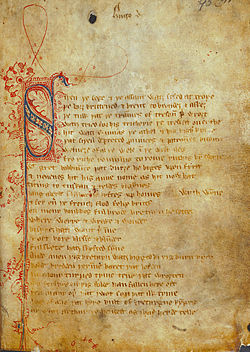| Sir Gawain and the Green Knight | |
|---|---|
 First page of the only surviving manuscript, c. 14th century | |
| Author(s) | Gawain Poet (anonymous) |
| Language | Middle English, North West Midlands dialect |
| Date | late 14th century |
| Provenance | Henry Savile, Yorkshire |
| Series | together with Pearl, Cleanness and Patience |
| Manuscript(s) | Cotton Nero A.x. |
| First printed edition | 1839 by Sir Frederic Madden |
| Genre | Narrative poem, chivalric romance, Arthurian and alliterative verse |
| Verse form | Alliterative Revival with bob and wheel |
| Length | 101 stanzas, 2530 lines |
| Subject | King Arthur's Court, testing morality |
| Setting | North Wales, West Midlands, Peak District |
| Personages | Sir Gawain, The Green Knight/Bertilak de Hautdesert, Lady Bertilak, Morgan le Fay, King Arthur, Knights of the Round Table |
| Text | Sir Gawain and the Green Knight at Wikisource |
Sir Gawain and the Green Knight is a late 14th-century chivalric romance in Middle English alliterative verse. The author is unknown; the title was given centuries later. It is one of the best-known Arthurian stories, with its plot combining two types of folk motifs: the beheading game and the exchange of winnings. Written in stanzas of alliterative verse, each of which ends in a rhyming bob and wheel,[1] it draws on Welsh, Irish, and English stories, as well as the French chivalric tradition. It is an important example of a chivalric romance, which typically involves a hero who goes on a quest which tests his prowess. It remains popular in modern English renderings from J. R. R. Tolkien, Simon Armitage, and others, as well as through film and stage adaptations.
The story describes how Sir Gawain, who was not yet a knight of King Arthur's Round Table, accepts a challenge from a mysterious "Green Knight" who dares any man to strike him with his axe if he will take a return blow in a year and a day. Gawain accepts and beheads him, after which the Green Knight stands, picks up his head, and reminds Gawain of the appointed time. In his struggles to keep his bargain, Gawain demonstrates chivalry and loyalty until his honour is called into question by a test involving the lord and the lady of the castle at which he is a guest. The poem survives in one manuscript, Cotton Nero A.x., which also includes three religious narrative poems: Pearl, Cleanness, and Patience. All four are written in a North West Midlands dialect of Middle English, and are thought to be by the same author, dubbed the "Pearl Poet" or "Gawain Poet".
- ^ Simpson, James (2007). "A Note on Middle English Meter". Sir Gawain and the Green Knight: A New Verse Translation. By Armitage, Simon. New York: Norton. ISBN 978-0-393-06048-5.